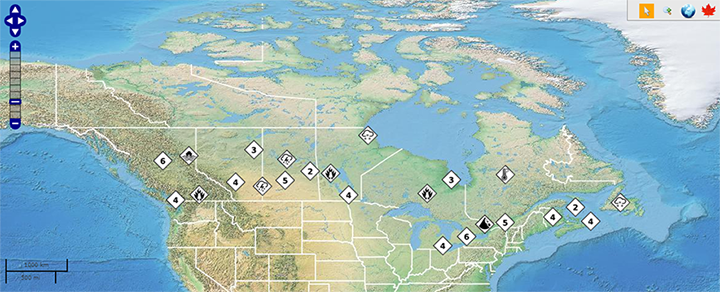Floods
Floods are the most costly natural disasters in Canada in terms of property damage. They can occur in any region, in the countryside or in cities, at virtually any time of the year. They have affected hundreds of thousands of Canadians. Most flooding occurs when the flow of water in a river or stream exceeds its channel. Floods also occur along the shoreline of lakes and oceans when water rises after high runoff, storm surge or the hammering of waves.
Fluctuations in water levels are natural occurrences. People generally relate high-water levels to flood conditions if the water threatens homes and lives, industry and our critical infrastructure (such as bridges, roads, pipelines and power sources).
Perhaps the most common cause of flooding is the accumulation of winter precipitation. Snow, sleet or hail sits frozen for several months, only to run off during the few short weeks of spring thaw. During this period, heavy rain, ice jams on rivers or a heavy snow cover and rapid melt can cause flooding. Among the worst in Canada's recent history were significant floods in Central and Southern Alberta in June 2013 and Manitoba's Red River flood of May 1997. Thousands of volunteers including residents, military personnel and volunteers worked together for over a month to battle spring floodwaters and evacuate 25,000 people from the dozens of affected communities.
Floods are number one in property damage
Next to spring thaw, heavy storm rainfall is the most common cause of flooding. Heavy rains caused by thunderstorms -- or warm, moist air rising rapidly -- can produce flash floods. The tropical storms and hurricanes of eastern Canada also carry the risk of heavy precipitation. Hurricane Hazel, in October 1954, deposited more than 100 millimetres of rain on the Toronto area in less than 12 hours. More than 80 people died.
In western Canada's mountains, heavy rain on steep slopes often results in flooding. Rain and melting snow in the mountains can cause channels to overflow -- or cause mud or debris flows -- as loose debris is swept up. Flash floods can also happen when water breaks out from a lake that was blocked by a glacier, earthen mass or a human-made structure. Prairie flood severity depends on depth of snow, snow water content when it starts to melt, how much moisture was in the soil in the fall and the extent of ground frost. Spring rainfalls and sudden warming can increase the potential of flooding.
Most Yukon and Northwest Territories floods follow spring ice break-up. Many communities in the Mackenzie River basin are subject to flooding because of geography and climate. The Mackenzie flows north. Spring break-up begins in its southern tributaries. Broken ice and warmer waters rush north on the Mackenzie to where winter is still in control and the river is frozen solid. The result is severe ice jams and floods.
The potential for flooding exists in many urban areas because Canadian cities developed along rivers, lakes and harbours due to the convenience of commerce and transportation. Federal, provincial and territorial governments have designated a number of flood prone areas in Canada. This was done to map out areas of high flood risk, to restrict development or redevelopment in these areas and to encourage local authorities to zone on the basis of flood risk.
For further information on specific events, see the Canadian Disaster Database.
To learn more about how individuals can get better prepared to cope with natural hazards, check out the information available from GetPrepared.
Emergency Management News Releases
Emergency Management Publications and Reports
- Government of Canada Response to the Public Order Emergency Commission Recommendations
- Advancing the Federal-Provincial-Territorial Emergency Management Strategy: Areas for Action
- Evaluation of the Initiatives to Address Post-Traumatic Stress Injuries (PTSI) Evaluation Report
- Summary of the Evaluation of the Initiatives to Address Post-Traumatic Stress Injuries (PTSI) Among Public Safety Officers
- The First Public Report of the National Risk Profile
- Date modified:
